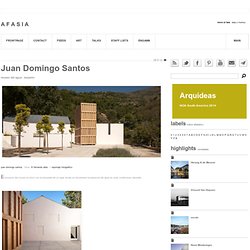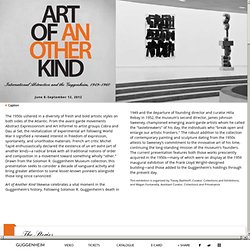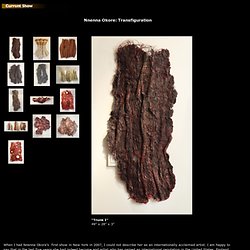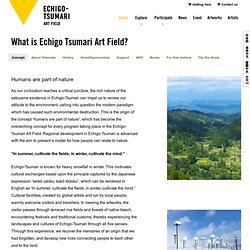

Steven Holl Architects sifang art museum . nanjing. Steven Holl Architects . photos: © Nanjing Sifang Art Museum . + dezeen . archdaily The new museum is sited at the gateway to the Contemporary International Practical Exhibition of Architecture in the lush green landscape of the Pearl Spring near Nanjing, China.

The museum explores the shifting viewpoints, layers of space, expanses of mist and water, which characterize the deep alternating spatial mysteries of the composition of Chinese painting. The museum is formed by a "field" of parallel perspective spaces and garden walls in black bamboo-formed concrete over which a light "figure" hovers. The straight passages on the ground level gradually turn into the winding passage of the figure above. Juan Domingo Santos museo del agua . lanjarón. Juan Domingo Santos . fotos: © Fernando Alda . + reportaje fotográfico El proyecto del museo se inició con la búsqueda de un lugar donde se favoreciera la presencia del agua en unas condiciones naturales.

El espacio elegido se encuentra situado en el acceso al Parque natural de sierra Nevada, junto al río Lanjarón y una acequia de riego que bordea unas antiguas construcciones utilizadas como matadero municipal. Dados los escasos medios disponibles la intervención ha consistido en el reciclaje y reutilización de algunos elementos del entorno.
Las naves del matadero, por ejemplo, se han adaptado a museo, y se han incorporado a las nuevas instalaciones los trazados de agua de la acequia y el río a través de un sencillo sistema de láminas de agua conectadas entre sí. ART OF ANOTHER KIND. In his first director's report to the board of trustees, James Johnson Sweeney prioritized, among other things, addressing the gap in the collection pertaining to sculpture.

Finding it too earthbound to communicate spiritually, founding director Hilla Rebay had not actively collected sculpture, save for a few examples by Alexander Calder, Claire Falkenstein, Naum Gabo, László Moholy-Nagy, and others. From early modernism, Sweeney added nine sculptures by Constantin Brancusi by 1958, creating a concentration of his work for the museum. Sweeney also acquired works by Jean Arp, Raymond Duchamp-Villon, Jacques Lipchitz, Amedeo Modigliani, and others. Five 1930s and 1940s Calder works were gifted from a major collector, though Sweeney had been Calder's close friend since they had met in Paris in the 1930s. Gordon Matta-Clark. Portfolio Office Baroque. Nacho Criado. Agentes colaboradores. Materializing "Six Years": Lucy R. Lippard and the Emergence of Conceptual Art. N.

E. Thing Co. Iain Baxter (Canadian, b. England, 1936) and Ingrid Baxter (American, b. 1938). 1. Time, detail from North American Time Zone Photo–V.S.I. September 14, 2012–February 17, 2013 This exhibition is devoted to examining the defining impact Lucy R. The exhibition will feature more than 170 objects by nearly ninety artists who were working internationally across a range of mediums. Materializing "Six Years" is organized by Catherine Morris, Curator of the Elizabeth A. This exhibition is made possible by the Elizabeth A. Alina Szapocznikow: Sculpture Undone, 1955–1972. A sculptor who began working during the postwar period in a classical figurative style, Alina Szapocznikow radically reconceptualized sculpture as an imprint not only of memory but also of her own body.

Though her career effectively spanned less than two decades (cut short by the artist’s premature death in 1973 at age 47), Szapocznikow left behind a legacy of provocative objects that evoke Surrealism, Nouveau Réalisme, and Pop art. Her tinted polyester casts of body parts, often transformed into everyday objects like lamps or ashtrays; her poured polyurethane forms; and her elaborately constructed sculptures, which at times incorporated photographs, clothing, or car parts, all remain as wonderfully idiosyncratic and culturally resonant today as when they were first made.
Parrish Art Museum. Current Show "Nnenna Okore: Transfiguration" Nnenna Okore: Transfiguration “Trunk I” 49” x 28” x 3” “Ndidi” 68” x 50” x 10” “Conjoined” 48” x 42” x 7”

Guggenheim Museum Bilbao. BES Photo 2013, 9.ª edição. Inventing Abstraction, 1910–1925. The Metropolitan Museum of Art - Home. American Legends: From Calder to O’Keeffe. Concept - Echigo-Tsumari Art Field. Humans are part of nature As our civilization reaches a critical juncture, the rich nature of the satoyama existence in Echigo-Tsumari can impel us to review our attitude to the environment, calling into question the modern paradigm which has caused such environmental destruction.

This is the origin of the concept “humans are part of nature”, which has become the overarching concept for every program taking place in the Echigo-Tsumari Art Field. Regional development in Echigo Tsumari is advanced with the aim to present a model for how people can relate to nature. “In summer, cultivate the fields; in winter, cultivate the mind.” Echigo-Tsumari is known for heavy snowfall in winter. Satoyama and Art The twentieth century was the era of the city and the art of the city. Artworks are dotted across approximately 200 villages rather than displayed in a single center, an “absolutely inefficient” approach deliberately at odds with the rationalization and efficiency of modern society.
Festival. Tate Modern. Google Art Project. Sistine Chapel.